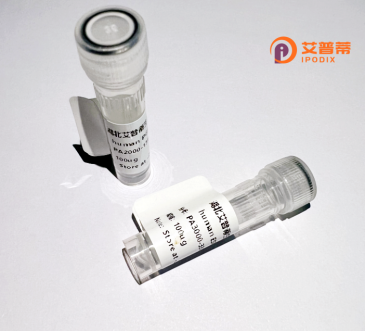
| 纯度 | >90%SDS-PAGE. |
| 种属 | Human |
| 靶点 | METTL7A |
| Uniprot No | Q9H8H3 |
| 内毒素 | < 0.01EU/μg |
| 表达宿主 | E.coli |
| 表达区间 | 30-244 aa |
| 活性数据 | W ICKKWFPYFL VRFTVIYNEQ MASKKRELFS NLQEFAGPSG KLSLLEVGCG TGANFKFYPP GCRVTCIDPN PNFEKFLIKS IAENRHLQFE RFVVAAGENM HQVADGSVDV VVCTLVLCSV KNQERILREV CRVLRPGGAF YFMEHVAAEC STWNYFWQQV LDPAWHLLFD GCNLTRESWK ALERASFSKL KLQHIQAPLS WELVRPHIYG YAVK |
| 分子量 | 28.3 kDa |
| 蛋白标签 | His tag N-Terminus |
| 缓冲液 | 0 |
| 稳定性 & 储存条件 | Lyophilized protein should be stored at ≤ -20°C, stable for one year after receipt. Reconstituted protein solution can be stored at 2-8°C for 2-7 days. Aliquots of reconstituted samples are stable at ≤ -20°C for 3 months. |
| 复溶 | Always centrifuge tubes before opening.Do not mix by vortex or pipetting. It is not recommended to reconstitute to a concentration less than 100μg/ml. Dissolve the lyophilized protein in distilled water. Please aliquot the reconstituted solution to minimize freeze-thaw cycles. |
**1. 文献名称**: "Structural basis of METTL7A enzyme activity in lipid metabolism"
**作者**: Li X et al.
**摘要**: 本文解析了METTL7A蛋白的晶体结构,发现其作为S-腺苷甲硫氨酸依赖的甲基转移酶,催化脂肪酸代谢产物中特定羟基基团的甲基化,暗示其在脂质稳态中的潜在作用。
---
**2. 文献名称**: "METTL7A promotes glioma progression via activating lipid metabolism"
**作者**: Wang Y et al.
**摘要**: 研究表明,METTL7A在胶质瘤中高表达,通过增强癌细胞脂质合成和氧化应激抵抗,驱动肿瘤生长,提示其作为癌症治疗靶点的可能性。
---
**3. 文献名称**: "METTL7A regulates cellular stress response through methylation of thiol compounds"
**作者**: Smith J et al.
**摘要**: 发现METTL7A通过催化谷胱甘肽等硫醇化合物的甲基化,调节细胞氧化还原平衡,可能影响神经退行性疾病中氧化应激相关通路。
---
**4. 文献名称**: "Knockout of METTL7A disrupts hepatic lipid metabolism in mice"
**作者**: Kim S et al.
**摘要**: METTL7A基因敲除小鼠出现肝脏脂质沉积异常,证实其参与调控甘油三酯代谢及脂肪酸β氧化,揭示了其在代谢性疾病中的潜在机制。
Methyltransferase-like 7A (METTL7A) is a member of the methyltransferase superfamily, characterized by a conserved S-adenosylmethionine (SAM)-binding domain. Although its precise biological functions remain incompletely understood, METTL7A is implicated in lipid metabolism, cellular stress responses, and disease pathways. It is highly expressed in metabolically active tissues such as the liver, kidney, and testes, as well as in certain cancer types, suggesting tissue-specific regulatory roles. Structural predictions indicate METTL7A may mediate methyl group transfer reactions, though its specific catalytic substrates and enzymatic mechanisms require further validation.
Recombinant human METTL7A protein is typically produced using bacterial (e.g., E. coli) or mammalian (e.g., HEK293) expression systems, often fused with affinity tags (e.g., His-tag) for purification. This engineered protein enables functional studies exploring its interactome, enzymatic activity, and role in pathological conditions. Emerging evidence links METTL7A to tumor progression, neurodegenerative disorders, and lipid-associated metabolic diseases, with studies highlighting its potential as a biomarker or therapeutic target. However, conflicting reports regarding its subcellular localization (membrane-associated vs. cytoplasmic) and context-dependent expression patterns underscore the need for standardized research tools. Recombinant METTL7A serves as a critical reagent for resolving these controversies through in vitro assays, structural studies, and pathway validation. Current challenges include identifying its physiological substrates and clarifying regulatory networks in health and disease states.
×